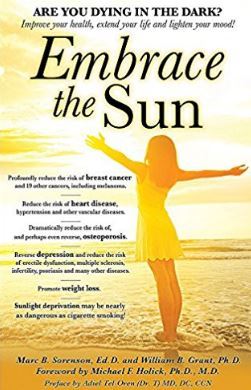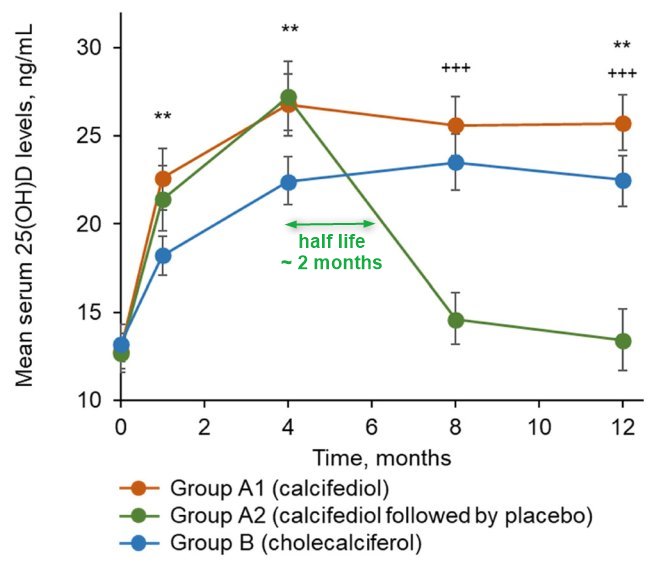Embrace the Sun – benefits of the sun (Nitric Oxide etc.) – book
Embrace the Sun Amazon - no longer in print - Used $149
Are you dying in the Dark?
If you avoid the sun, you may be ruining your health.
Sun avoidance may be as dangerous to your health as cigarette smoking
By: Marc B.Sorenson, Ed. D. and William B. Grant, Ph.D.

Most of the health benefits of the sun are due to the UVB production of Vitamin D around noon.
However, the authors point out in detail, the additional non-noon benefits of the sun, due to UVA production of Nitric Oxide in the skin
Previous to this book I was only enjoying the sun at noon in the summer (Seattle)
- This book made be be aware of the non-noon and non-summer benefits of the sun, which I had wondered about for years
UVA can get through windows, but UVB cannot
Blue or bright light decreases depression
Book table of contents
| Chapter 1 | Does Sun Exposure Cause Melanoma? | 1 |
| Chapter 2 | Other Diseases Related Positively or Negatively to Sun Exposure | 17 |
| Chapter 3 | Estimating the Incidence of Deadly Diseases Associated with a Lack of UVR Exposure | 21 |
| Chapter 4 | Boning Up: Sun Exposure Maintains and Increases Bone Strength and Joint Health | 39 |
| Chapter 5 | Cancer Prevention: Sun Exposure Is Essential | 53 |
| Chapter 6 | Preventing Diseases of the Heart, Brain and Vascular System: The Vital Need for Sun Exposure | 85 |
| Chapter 7 | The Protective Affect of the Sun on Type-Two Diabetes, Type-One Diabetes and Other Autoimmune Diseases | 101 |
| Chapter 8 | Sun Exposure and Infectious Diseases | 121 |
| Chapter 9 | Mental and Neurological Conditions Influenced by the Sun | 139 |
| Chapter 10 | The Influence of Sun Exposure on Other Disorders | 167 |
| Chapter 11 | Sun Exposure, Pregnancy, Lactation and other Reproductive Issues | 197 |
| Chapter 12 | Racial Disparities Related to Differences in UVB Exposure and Vitamin D Status | 205 |
| Chapter 13 | How Did the Sun So Quickly Change From Friend To Foe? A brief History of the Rise and Fall of Heliotherapy | 211 |
| Appendix 1 | The Magnificent Sun | 219 |
| Appendix 2 | Balancing the Messages about Sunbeds | 227 |
| Appendix 3 | Sunscreens: Dangerous At Best and At Worst Potentially Deadly | 241 |
| Appendix 4 | Understanding Proper Circadian Rhythms and the Critical Importance of Sunlight in Maintaining Them | 251 |
| Appendix 5 | The Assault on the Sun: Dishonesty, Duplicity and Dollars | 255 |
| Appendix 6 | Salubrious Solar Solutions: Photo-Nutrient Supplements vs Civilization's Sun-Deficiency Epidemic | 271 |
| No index |
Examples of # of words in book
| 1094 | Cancer |
| 1051 | Vitamin d |
| 595 | Melanoma |
| 134 | Mortality |
| 121 | Diabetes |
| 85 | UVA |
| 71 | Asthma |
| 67 | Multiple sclerosis |
| 67 | Cardiovascular |
| 58 | Nitric Oxide |
| 57 | Osteoporosis |
| 52 | Blue |
| 44 | Depression |
| 29 | Rickets |
| 25 | Windows |
| 22 | COPD |
| 20 | Parkinson |
| 17 | Lung Cancer |
I used SublimeText. to find words and phrases in the book
SublineText is a free program which finds and highlights text instantly. Very easy to use on Windows, MAC, or Linux
TXT file contains NO formatting - such as bold, italic, underline, heading, etc.
The Headlines
Voluminous research in the past few years has proved the truth about the remarkable health benefits of the Sun. Why haven't you read these Headlines?
Sun exposure in the U.S. has been reduced by 90% in the last 70-100 years, while the risk of melanoma has increased by at least 3,000%. Then how can anyone believe sun exposure causes melanoma?
As in the US, while sun exposure in Europe has profoundly decreased, there has been a spectacular increase in melanoma.
Many melanomas occur on the parts of the body that seldom or never see the sun, including inside and around sex organs, in the armpits, in the mouth, on the soles of the feet and on areas nearly always covered by clothing.
Women who completely avoid the sun have an increased risk of breast cancer of 1,000%, compared to those regularly exposed to sun.
Women in Spain who actively seek the sun have a reduced risk of hip fracture of 91%.
Sunbathing can often reduce both systolic and diastolic blood pressure within an hour, and the effect lasts for about two more hours.
Multiple Sclerosis is most prevalent in the northern part of the Northern hemisphere, but its prevalence virtually disappears in sunny equatorial climes.
Selective serotonin reuptake inhibitors (SSRI) such as Prozac work by keeping serotonin in circulation. Sun exposure can increase the amount of serotonin in the circulation by 800% in one day without toxic side effects, and the sun is free.
Regular, habitual sun exposure without sunscreens REDUCES the risk of melanoma.
Outdoor workers obtain 3-10 times the annual sunlight exposure as indoor workers, yet they have lower incidences of melanoma. Why?
Women with active sunbathing habits live longer.
Women who avoid sun exposure have twice the risk of allcause death over 20 years, compared to those who are actively in the sun.
Chronic sun exposure is associated with a reduced risk of colorectal, breast, and prostate cancer.
Regular exposure to UV leads to an almost complete disappearance of DNA damage where skin cancer has been initiated.
There are 324 deaths associated with diseases of low sun exposure for every 1 death related to diseases of high sun exposure.
UV radiation, from sunlight, is the best natural source of vitamin D. Vitamin D supplements alone are not an effective substitute for adequate sun exposure.
Public health messages in the past 50 years, urging avoidance of sun exposure and the use of chemical sunscreens, have likely contributed to the rise in melanoma incidence.
Chemical sunscreens have unbalanced Mother Nature, which is one reason why melanoma has INCREASED exponentially, accompanying the exponential increase in sunscreen sales during the past 30 years.
DNA damage is reduced with a tan.
Low blood levels of vitamin D are a major indicator of sunlight deficiency.
If sunscreen is not re-applied every hour it creates more skin damage than if one used nothing at all.
Women who used sunbeds for 20 years had a 23% decrease in the risk for all-cause death.
Diseases associated with low sun exposure in the USA
| Disease | Year | Deaths |
| Osteoporosis | 2005 | 71,280 |
| Osteoarthritis | 2004 | 500 |
| Rheumatoid arthritis | 1998 | 2,060 |
| Bladder cancer | 2016 | 16,390 |
| Brain cancer | 2016 | 16,050 |
| Breast cancer | 2016 | 40,980 |
| Cervical cancer | 2016 | 4,074 |
| Colon cancer | 2016 | 49,190 |
| Endometrial cancer | 2016 | 10,470 |
| Gallbladder cancer | 2016 | 3,710 |
| Kidney cancer | 2016 | 14,240 |
| Lung cancer | 2016 | 158,080 |
| Leukemia | 2016 | 24,400 |
| Lymphoma | 2016 | 21,270 |
| Multiple Myeloma | 2016 | 12,650 |
| Oral and pharyngeal | 2016 | 9570 |
| Ovarian cancer | 2016 | 14,240 |
| Pancreatic cancer | 2016 | 34,920 |
| Prostate cancer | 2016 | 26,120 |
| Thyroid Cancer | 2016 | 1,980 |
| Cardiovascular | 2015 | 801,000 |
| Diabetes | 2010 | 69,071 |
| Crohn's disease | 2004 | 825 |
| Asthma | 2010 | 4,000 |
| Influenza | 2010 | 36,000 |
| Pneumonia | 2016 | 53,282 |
| Septicemia | 2012 | 35,000 |
| HIV—Aids | 2013 | 6,995 |
| Necrotizing fasciitis | 2010 | 200 |
| Tuberculosis | 2014 | 555 |
| COPD | 2009 | 145,575 |
| Total annual deaths | 1,684,677 |
Diseases and disorders diminished by regular, non-burning sun exposure:
• Acute lower respiratory infection
• Anaphylaxis
• Anemia
• Anxiety
• Arthritis
• Asthma
• Athero-sclerosis
• Autoimmune diseases
• Bipolar disorder
• Breast-tissue density
• Chronic pain
• Cognitive decline
• Colds
• Craniotabes
• Crohn's disease
• Chronic obstructive pulmonary disease
• Cystic fibrosis
• Dental caries
• Eczema
• Electric light disease
• Epilepsy
• Erectile dysfunction
• Fibromyalgia
Flu
Heart disease
Heart failure
High cholesterol
Hypertension
HIV/AIDS
Compromised Immune system
Infectious mononucleosis
Infertility
Inflammation
Inflammatory bowel disease
Insomnia
Intermittent
claudication
Kidney disease
Leprosy
Leukemia
Low-back pain
Metabolic
Syndrome
Migraines
Mood disorders
Low muscle strength
Multiple Myeloma Myopia
Nursing home risk Obesity
Osteoporosis and fractures
Parasites
Parkinson's disease
Periodontal disease
Peripheral artery disease
Pre-eclampsia
Psoriasis
Rickets
Schizophrenia
Seasonal affective disorder (SAD)
Sepsis, Septicemia
Soft-tissue injury
Stroke
Tuberculosis
Ulcerative colitis
See also VtiaminDWiki
- Vitamin D Video 53 minutes with text and PDFs – Grant Oct 2017 one of the authors
{include}
Sunshine
The sun appears to generate Co-Q10 in our bodies when we eat our greens – Greger April 2016
2 cents of vitamin D far better than sunbathing for 30 minutes daily – Nov 2017
People who get little noon-day sun must supplement with Vitamin D – systematic review June 2017
Avoiding the sun reduces lifespan by 2 years (smoking reduces lifespan by 10 years) – March 2016
Sunburning reduced by 200,000 IU of Vitamin D – RCT April 2017
Parkinson’s disease 2 times less likely if get 2 hours of daily sun – Nov 2016
Less sun means more disease -Grant, Holick, Cannell, et al Feb 2015
Many wavelengths of light provide health benefits, not just UV – March 2016
The Shadow Rule – you make more Vitamin D when you are taller than your shadow – 1992
Sun is needed, but as with ice cream, getting too much can cause problems – Aug 2015
Skin directly benefits from the sun – no liver, kidney needed to create Vitamin D – Jan 2018
-
- half life of Vitamin D from sun or UV is about 2X of from supplements - wonder why

UV
Spring sunshine in snowy Finland normalized Vitamin D levels to 36 nanograms – 2017
Ultraviolet Light in Human Health, Diseases and Environment - book 2017
Health benefits of non-burning exposure to UV light – Jan 2017
Large variability in response to UV (more than response to oral Vitamin D) – March 2016
UVA decreased vitamin D levels (again) – July 2013
- It might not be good for your Vitamin D levels to work in front of a window
